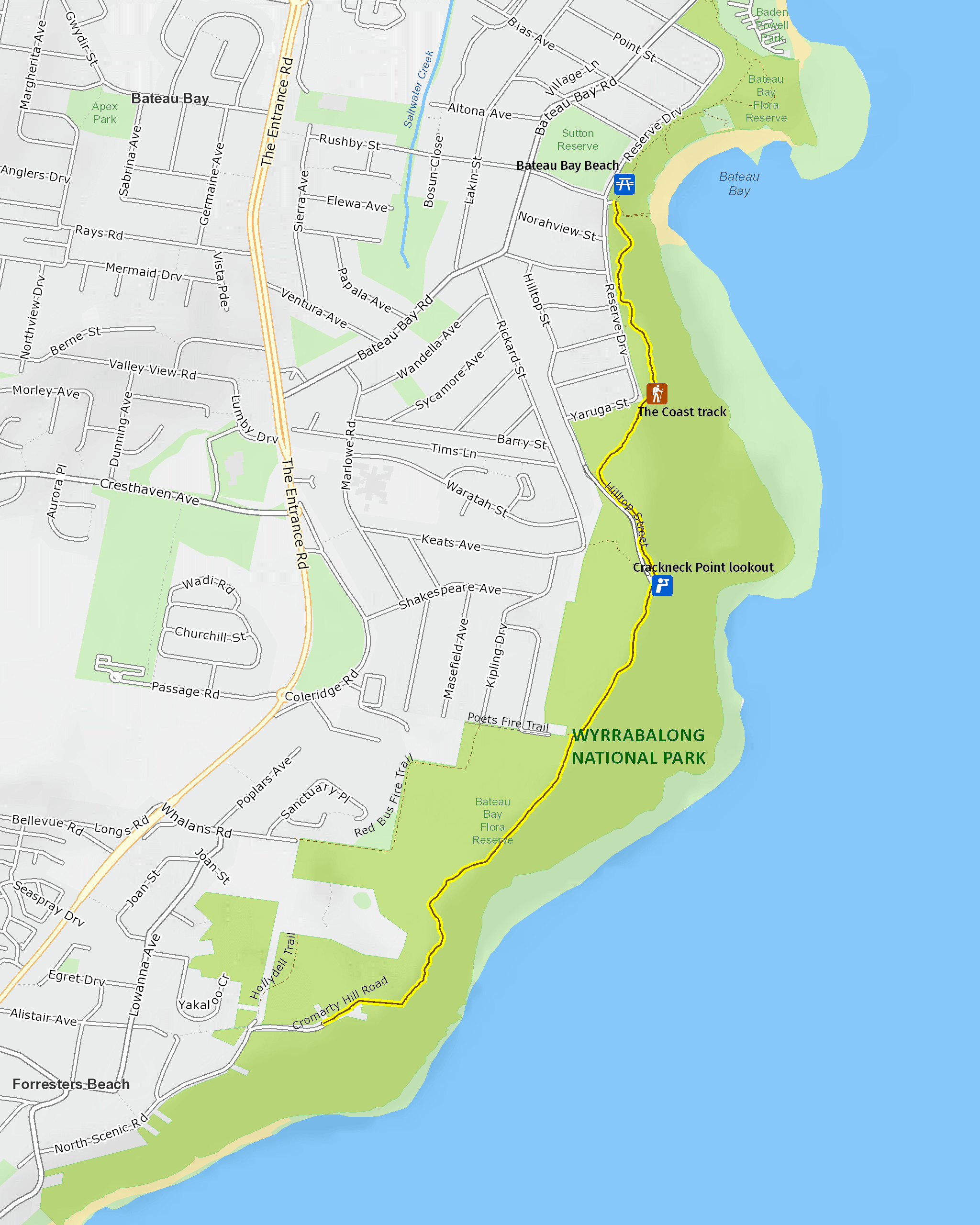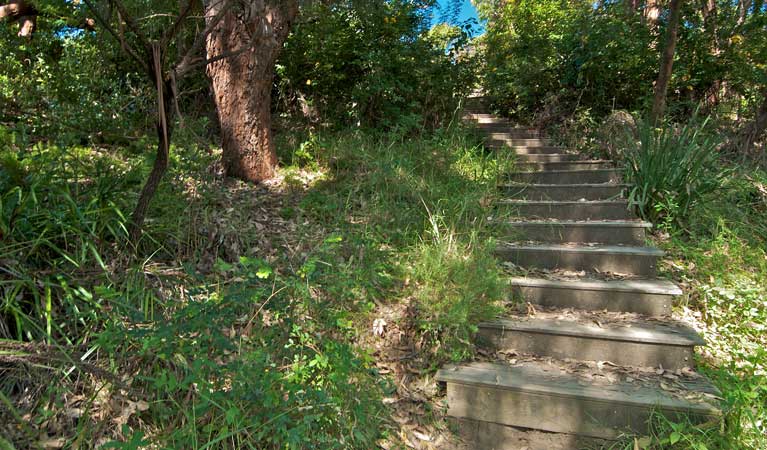Overview
Enjoy scenic views and wildflowers along The Coast walking track near Bateau Bay. This is a great winter walk, and there are excellent spots for whale watching along this easy walk in Wyrrabalong National Park.
- Distance
- 3km one-way
- Time suggested
- 1hr 15min - 1hr 45min
- Grade
- Grade 3
- What to
bring - Sunscreen, hat, drinking water
- Please note
- Remember to take your binoculars if you want to bird watch or whale watch.
Discover one of the Central Coast’s most beautiful walks. The Coast walking track runs through a narrow strip of forest between Forresters and Bateau Bay Beaches.
Setting out from Bateau Bay Beach picnic area, you'll wander along clifftops, past blackbutts and spotted gums, and absorb spectacular coastal views as you go. The best time to walk is between May and August, when you can do some whale watching from Crackneck lookout along the way. If you’re walking in spring, you’ll be treated to wildflowers coming into bloom, including ground orchids and flannel flowers, and you’re bound to spot birds all year round.
The return walk is about 6km, but if you’d like a shorter walk, try going one way, or you can break the walk up into shorter sections. No matter how you undertake it, you’re sure to find it rewarding.
Take a virtual tour of The Coast walking track captured with Google Street View Trekker.
Map

Map legend

Local alerts
For the latest updates on fires, closures and other alerts in this area, see https://www.nationalparks.nsw.gov.au/things-to-do/walking-tracks/the-coast-walking-track/local-alerts
General enquiries
- National Parks Contact Centre
- 7am to 7pm daily
- 1300 072 757 (13000 PARKS) for the cost of a local call within Australia excluding mobiles
- parks.info@environment.nsw.gov.au
Park info
- in Wyrrabalong National Park in the Sydney and surrounds region
Wyrrabalong National Park is open from 5.30am to 8pm during daylight saving and 5.30am to 6pm rest of year.
Visitor info
All the practical information you need to know about The Coast walking track.
Track grading
Features of this track
Distance
3km one-way
Time
1hr 15min - 1hr 45min
Quality of markings
Clearly sign posted
Experience required
No experience required
Gradient
Short steep hills
Steps
Many steps
Quality of path
Formed track
Getting there and parking
Get driving directions
The Coast walking track goes from Bateau Bay south to Forresters Beach. You can start the track at either end, or at one of the access points along the way, or including Crackneck lookout.
To start the walk from Bateau Bay:
- Take The Entrance Road and turn east into Yakalla Street
- Turn right onto Bateau Bay Road and then left into Reserve Drive
- The track starts from Bateau Bay Beach picnic area on Reserve Drive
To start the walk from Forresters Beach:
- Take The Entrance Road and turn east into Crystal Street
- Turn left into Kalakau Avenue, which becomes South Scenic Road
- Turn right into North Scenic Road, which becomes Cromarty Hill Road
- Park near the gate and follow the track up to the Wyrrabalong lookout, where the track begins
Parking
- Parking is available at Bateau Bay Beach picnic area a short walk from the northern end of The Coast walking track
- Parking is available on North Scenic Drive, a short walk to Wyrrabalong lookout and the southern end of The Coast walking track
Best times to visit
There are lots of great things waiting for you in Wyrrabalong National Park. Here are some of the highlights.
Spring
A spring visit allows you to see gorgeous wildflower displays as you walk through the park.
Summer
It's summertime and the water's great – visit to surf, swim or snorkel in the park's superb beaches and it's a great time of year to fish for prawns and blue swimmer crabs at Tuggerah Lake.
Winter
Head to Wyrrabalong or Crackneck lookouts – these high headlands are perfect posts for watching whales on their northern migration.
Weather, temperature and rainfall
Summer temperature
Average
20°C and 25°C
Highest recorded
42.4°C
Winter temperature
Average
10°C and 17°C
Lowest recorded
3.4°C
Rainfall
Wettest month
February
Driest month
August
The area’s highest recorded rainfall in one day
246mm
Maps and downloads
Prohibited
Pets
Pets and domestic animals (other than certified assistance animals) are not permitted. Find out which regional parks allow dog walking and see the pets in parks policy for more information.
Smoking
NSW national parks are no smoking areas.
Learn more
The Coast walking track is in Wyrrabalong National Park. Here are just some of the reasons why this park is special:
Aboriginal culture

North Wyrrabalong forms part of traditional Country of the Awabakal People, with south Wyrrabalong (cut off from the north by The Entrance channel) being Darkinjung Country. The park has a rich Aboriginal history and protects many significant cultural sites, including an extensive midden at Pelican Point. You can take a guided tour with Nyanga Walang to find out more about local Darkinjung history.
Red gum forest

The northern section of Wyrrabalong National Park protects the largest stand of Sydney red gums, or Angophoras, on the Central Coast. Explore the red gum forest and enjoy the shade of these magnificent native trees along the Red Gum trail in north Wyrrabalong. See how the forest changes depending on the season – trunks change from orange in summer to pinkish-grey in winter. Visit around December to see the trees adorned with white flowers, and spot honeyeaters in the branches in wintertime. The park is also an important haven for a variety of wildlife, including a number of threatened migratory birds that visit the coastal strip between Forresters Beach and Blue Lagoon in the park’s southern section. There’s even a population of marine turtles in Tuggerah Lake – if you’re lucky, you might see a loggerhead turtle; they have a large head in proportion to the rest of its body.
- Junior ranger: Whale tales at Wyrrabalong Hey junior whale watchers! These school holidays have fun whale watching at Crackneck Point lookout in Wyrrabalong National Park, near The Entrance. Learn how to spot whales on their annual migration.
- Lillypilly loop trail The easy Lillypilly loop trail is a lovely rainforest walk on the NSW Central Coast. Enjoy birdwatching and scenic views over Tuggerah Lakes.
- Pelican Beach Road lookout Pelican Beach Road lookout offers scenic views over The Entrance and Pelican Beach and is a great spot for whale watching. The beach is popular for fishing and surfing.
Whale watching

The park's spectacular coastal lookouts - both north and south - are ideal vantage points for whale watchers. Bring your binoculars to Crackneck Point lookout in whale watching season and prepare to be astounded. Whales are frequently seen breaching and tail-slapping nearby. And watch for the blow as they surface for air - there's really nothing like it.
- Tandem paragliding on the NSW Central Coast Take a tandem flight with Cloudbase Paragliding and be treated to a stunning bird’s eye view of Wyrrabalong National Park on the NSW Central Coast.
Plants and animals protected in this park
Animals
-

Australian pelican (Pelecanus conspicillatus)
The curious pelican is Australia’s largest flying bird and has the longest bill of any bird in the world. These Australian birds are found throughout Australian waterways and the pelican uses its throat pouch to trawl for fish. Pelicans breed all year round, congregating in large colonies on secluded beaches and islands.
-

Brown-striped frog (Lymnastes peronii)
One of the most common frogs found in Australia, the ground-dwelling brown-striped frog lives in ponds, dams and swamps along the east coast. Also known as the striped marsh frog, this amphibian grows to 6.5cm across and has a distinctive ‘tok’ call that can be heard all year round.
Plants
-

Cabbage palm (Livistona australis)
With glossy green leaves spanning 3-4m in length and a trunk reaching a height of up to 30m, the cabbage tree palm, or fan palm, is one of the tallest Australian native plants. Thriving in rainforest margins along the east coast of NSW, in summer this giant palm produces striking spikes of cream flowers which resemble cabbages.
-

Old man banksia (Banksia serrata)
Hardy Australian native plants, old man banksias can be found along the coast, and in the dry sclerophyll forests and sandstone mountain ranges of NSW. With roughened bark and gnarled limbs, they produce a distinctive cylindrical yellow-green banksia flower which blossoms from summer to early autumn.
Environments in this park
General enquiries
- National Parks Contact Centre
- 7am to 7pm daily
- 1300 072 757 (13000 PARKS) for the cost of a local call within Australia excluding mobiles
- parks.info@environment.nsw.gov.au
Park info
- in Wyrrabalong National Park in the Sydney and surrounds region
Wyrrabalong National Park is open from 5.30am to 8pm during daylight saving and 5.30am to 6pm rest of year.

